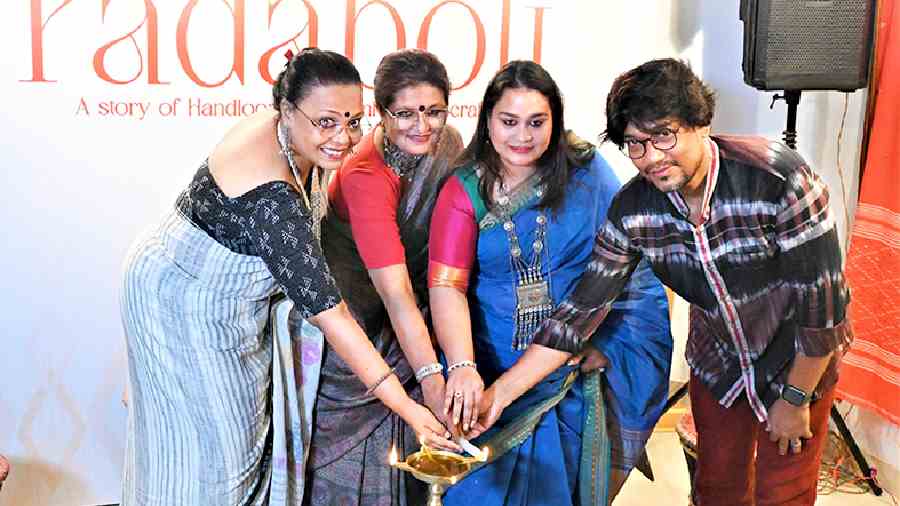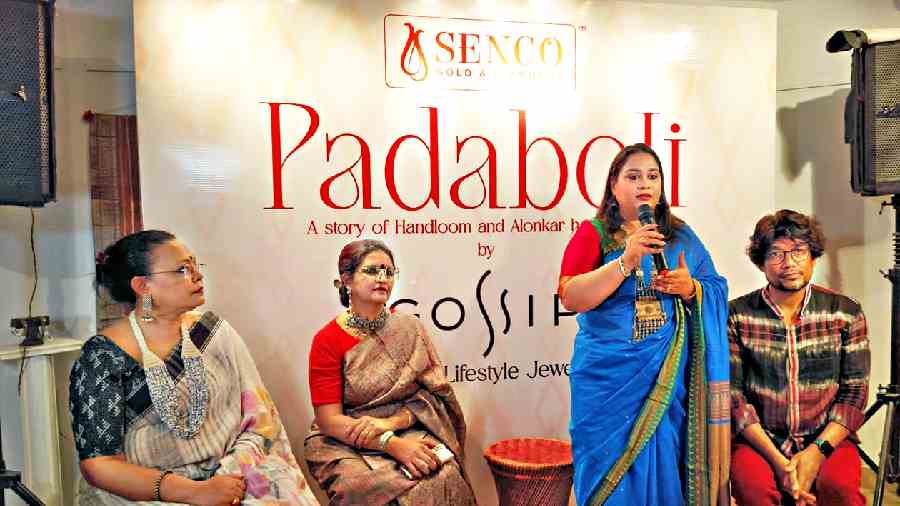One of the largest jewellery retailers in eastern India, Senco Gold & Diamonds recently unveiled Padaboli, a jewellery collection launched under its fashion and lifestyle jewellery sub-brand Gossip. The collection comprises handmade ornaments made of silver and various alloys, in styles that reflect the tastes of the contemporary woman.
To celebrate the launch, Senco Gold & Diamonds hosted a four-day exhibition from March 23 - 26 at Gallery Gold Art Centre that showcased the new range. The exhibition also featured an exclusive collection of handwoven, traditional saris designed by renowned textile designer and weaver Manas Ghorai. The show represented a unique collaboration between Senco Gold & Diamonds and the weavers of Bengal, with the new line of semi-precious jewellery borrowing inspiration from jamdani, kantha stitch and other traditional handloom saris. Geometric patterns and motifs of birds, animals, flowers, leaves and more that adorn traditional saris of Bengal, have been replicated by jewellery artisans to develop this unique line of jewellery that has a contemporary look and feel. Each sari at the exhibition was displayed along with the complementing necklaces, earrings, and bangles. In its second edition after the success of the first edition in 2022, the collaboration also provides a platform for restoring the craft heritage of Bengal's weavers and artisans who practice centuries-old, forgotten, weaving techniques.
The Telegraph chatted with Joita Sen, Senco Gold & Diamonds director and head of marketing, on the Padaboli range, the concept of the exhibition and more.
Congratulations on the launch of the new Padaboli collection and the exhibition. Do share with us your thoughts about it.
The thoughts behind this collection are manifold. You see, women often want to reinvent their way of dressing up by trying something new that matches their personality, particularly for special occasions. Padaboli is Senco Gold & Diamonds' way of offering our patrons a whole new range of jewellery for Poila Baisakh that is traditional, yet very different, stylish and versatile as well. This collection also represents our wish to celebrate, showcase and support the skill, creativity and craftsmanship of Bengal's jewellery artisans, whose creations are adorning women all over the world. Designing and creating each piece for this collection was a challenge as the artisans had to discover and implement new ways of practising an art form that has been handed down to them over generations. This initiative has also been conceived as a confluence of the traditional art forms of hand-weaving and jewellery-making, where each craft needed to be modified and adapted to make its design suitable to be incorporated by the other. This was therefore a display of art and craftsmanship, and so we decided to host the exhibition at an art gallery and not in our showrooms.
How were the designs for the new collection selected and developed? Does it follow any theme?
As you know, our new collection is named Padaboli, which actually means a story made up of many characters and incidents. So, the pieces of this collection also have a story to tell. Moreover, the collection is made up of various kinds of handwoven saris, each spun according to its own technique, and many different kinds of innovative jewellery pieces that match the sari designs. As with the first edition of Padaboli, which was organised last year, this year too, we collaborated with textile designer and researcher Manas Ghorai and his team, for designs that would be appropriate for both saris and jewellery. For this collection, old weaves and designs of handloom and handwoven saris that are no longer used were brought back to the design table and modified for a modern palette. These designs were then adapted by our team of karigars, who had to innovate upon their usual techniques to achieve the desired texture, look and finish of each item of jewellery. The whole process tested the skills of our karigars to the maximum and it was a proud moment for us when we could achieve it through our collective efforts.

(L-R) Singer Lopamudra Mitra and Jayati Mukherjee, National Institute of Fashion Technology jewellery designing faculty, who were guests at the inauguration, joined Joita Sen and designer Manas Ghorai in lighting the inaugural lamp.

Lopamudra Mitra (extreme left) and Jayati Mukherjee (second from left) displayed a choker and earrings set inspired by the designs on a traditional handwoven sari. Manas Ghorai (second from right) held up a handloom sari whose border inspired the design of the jhumka earrings in his hand, while Joita Sen (extreme right) displayed a jewellery set also inspired by the design of a sari.
Coming to the Gossip line of fashion jewellery, what is the focus of the label and who are its target buyers?
A sub-brand of Senco, Gossip deals with silver and fashion jewellery. It is also a brand that allows me to experiment and innovate and offers me an outlet for my creative instincts. Through Gossip, our patrons get the advantage of checking out fusion designs, experimental collections and jewellery designed through creative collaborations like Padaboli that are contemporary in design, fashionable, fit for all occasions and yet easy on the pocket. So Gossip is a brand that allows us to reach out and cater to a larger number of buyers and give them the opportunity to wear beautifully designed, well-crafted, lightweight jewellery that also has a fuller look.
What sort of response did you get from the show?
This time, the saris of our collection were soft, cool and summery, though traditional in design. And we tried to make our jewellery designs as lightweight as possible. We also ensured that our designs were versatile so that the jewellery pieces could be paired with any other sari or dress besides the one with which they had been matched. In fact, all our jewellery designs for this collection had a contemporary twist, though based on traditional motifs and designs. One of our main intentions was to make this collection stylish yet affordable. All these factors helped us get a very good response, and we made lots of outright sales from the exhibition itself, other than accepting orders. Another important aspect I would like to mention is that we had visitors and buyers across all age groups at the exhibition. And that's because, no matter how much we change with the times, Bengalis remain very traditional at heart. Bengalis across generations wish to dress up in their traditional best on Poila Baisakh and the Padaboli exhibition offered them the perfect opportunity to do it in style.
Do you think this can be the start of a new fashion trend?
I hope so. What satisfied me the most about this exhibition was that our visitors were really enthusiastic and excited by the concept and designs on show. They enjoyed the element of modernity that we had fused with traditional patterns. And as I mentioned earlier, we had teenagers, young ladies, middle-aged women and even older women as visitors and there was something to interest everybody in this collection. Each age group had something suitable for their age and personality and some saris and jewellery were appropriate for women of all ages. That's why the collection turned out to be quite popular. And though this concept of pairing jewellery designs with that of the motifs found in traditional weaves has been exclusively thought out and developed by us, I will be happy if this catches on as a trend. For ultimately, it will give more exposure and value to the skill of Bengal's weavers and artisans, which is one of our key objectives for creating this collection.
Is any other fashion collaboration on the cards?
I am always open to new ideas and experimentation provided it can lead to something new and more beautiful for our customers to enjoy. Gossip as a line, lends itself to a whole lot of innovation, but at the moment, we would like to focus on Padaboli, not only because it is being widely appreciated but also because we want to give people new ideas and options when they dress up in traditional ensembles for occasions like Poila Baisakh and Durga Puja.
